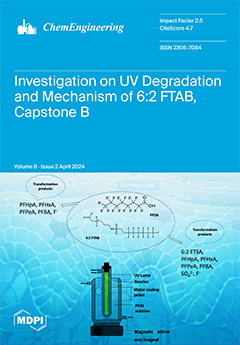To simultaneously solve problems in an eco-friendly manner, introducing a waste residual as a sustainable conditioner to aid alum sludge dewatering is suggested as a cradle-to-cradle form of waste management. In this regard, the superiority of deep dewatering alum sludge with a powdered
[...] Read more.
To simultaneously solve problems in an eco-friendly manner, introducing a waste residual as a sustainable conditioner to aid alum sludge dewatering is suggested as a cradle-to-cradle form of waste management. In this regard, the superiority of deep dewatering alum sludge with a powdered wood chip composite residual as a novel conditioner was explored, whereby traditional conventional conditioners, i.e., polyelectrolytes and lime, were substituted with powdered wood chips. Initially, Fe
3O
4 was prepared at the nanoscale using a simple co-precipitation route. Next, wooden waste was chemically and thermally treated to attain cellulosic fine powder. Subsequently, the resultant wood powder and Fe
3O
4 nanoparticles were mixed at 50 wt % to attain a wood powder augmented with iron, and this conditioner was labeled nano-iron-cellulose (nIC-Conditioner). This material (nIC-Conditioner) was mixed with hydrogen peroxide to represent a dual oxidation and skeleton builder conditioning substance. Characterization of the resultant conditioner was carried out using transmission electron microscopy (TEM) and Fourier transform infrared (FT-IR) transmittance spectrum analysis. The feasibility of the experimental results revealed that the moisture content in the sludge cake was lower after conditioning, and the capillary suction time (CST) was reduced to 78% compared to that of raw alum sludge after 5 min of dewatering time. Moreover, the optimal system parameters, including nIC-Conditioner and H
2O
2 concentrations, as well as the working pH, were optimized, and optimal values were recorded at 1 g/L and 200 mg/L for nIC-Conditioner and H
2O
2, respectively, with a pH of 6.5. Additionally, scanning electron microscope (SEM) analyses of the sludge prior to and after conditioning were conducted to verify the change in sludge molecules due to this conditioning technique. The results of this study confirm the sustainability of an alum sludge and waste management facility.
Full article





